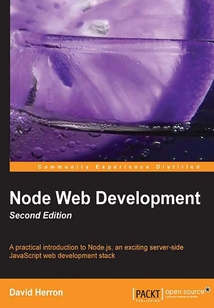首頁(yè) > 計(jì)算機(jī)網(wǎng)絡(luò) >
編程語(yǔ)言與程序設(shè)計(jì)
> Node Web Development(Second Edition)最新章節(jié)目錄
舉報(bào) 

會(huì)員
Node Web Development(Second Edition)
最新章節(jié):
Index
Presentedinasimple,step-by-stepformat,thisbookisanintroductiontowebdevelopmentwithNode.ThisbookisforanybodylookingforanalternativetothePlanguages(Perl,PHP,Python),oranyonelookingforanewparadigmofserver-sideapplicationdevelopment.ThereadershouldhaveatleastarudimentaryunderstandingofJavaScriptandwebapplicationdevelopment.
目錄(73章)
倒序
- 封面
- 版權(quán)信息
- Credits
- About the Author
- Acknowledgement
- About the Reviewers
- www.PacktPub.com
- Preface
- Chapter 1. About Node
- The capabilities of Node
- Why should you use Node?
- What's in a name – Node Node.js or Node.JS?
- Summary
- Chapter 2. Setting up Node
- System requirements
- Installing Node using package managers
- Installing the StrongLoop Node distribution
- Installing from source on POSIX-like systems
- Installing developer tools on Mac OS X
- Run a few commands; testing the commands
- npm – the Node package manager
- Starting Node servers at system startup
- Summary
- Chapter 3. Node Modules
- Defining a module
- Node package manager
- Summary
- Chapter 4. HTTP Servers and Clients – A Web Application's First Steps
- Sending and receiving events with EventEmitters
- HTTP server applications
- HTTP Sniffer – listening to the HTTP conversation
- Web application frameworks
- Getting started with Express
- Calculating the Fibonacci sequence with Express
- Making HTTP Client requests
- Calling a REST backend service from an Express application
- Summary
- Chapter 5. Implementing a Simple Express Application
- Express and the MVC paradigm
- Creating the Notes application code
- Changing the look of an Express application
- Scaling up and running multiple instances
- Summary
- Chapter 6. Data Storage and Retrieval
- Asynchronizing the Notes application
- Storing notes in files
- Storing notes with the LevelUP data store
- Storing notes in SQL – SQLite3
- Storing notes the ORM way with the Sequelize module
- Storing notes in MongoDB with Mongoose
- Summary
- Chapter 7. Multiuser Authorization Deployment Scaling and Hosting
- User authentication
- Deploying Notes on Debian
- Scaling to use all cores on multi-core servers
- Deploying Notes on cloud hosting (AppFog)
- Summary
- Chapter 8. Dynamic Interaction between the Client and Server Application
- Adding real-time web features to Notes
- Introducing Socket.IO
- Initializing Socket.IO with Express
- Events between the Notes server and client code
- Running the Notes application with Socket.IO
- Sending messages between users
- Summary
- Chapter 9. Unit Testing
- Testing asynchronous code
- Assert – the simplest testing methodology
- Testing a model
- Testing router functions
- Making it easy to run the tests
- Summary
- Index 更新時(shí)間:2021-08-13 16:47:04
推薦閱讀
- AngularJS入門與進(jìn)階
- Mastering Adobe Captivate 2017(Fourth Edition)
- 大學(xué)計(jì)算機(jī)基礎(chǔ)實(shí)驗(yàn)教程
- 構(gòu)建移動(dòng)網(wǎng)站與APP:HTML 5移動(dòng)開發(fā)入門與實(shí)戰(zhàn)(跨平臺(tái)移動(dòng)開發(fā)叢書)
- Learning Bayesian Models with R
- The DevOps 2.5 Toolkit
- Node.js全程實(shí)例
- RSpec Essentials
- Linux C編程:一站式學(xué)習(xí)
- 用戶體驗(yàn)可視化指南
- Building Microservices with .NET Core
- Orleans:構(gòu)建高性能分布式Actor服務(wù)
- Go語(yǔ)言底層原理剖析
- 后臺(tái)開發(fā):核心技術(shù)與應(yīng)用實(shí)踐
- SpringBoot從零開始學(xué)(視頻教學(xué)版)
- Functional Python Programming
- 基于MATLAB的控制系統(tǒng)仿真及應(yīng)用
- INSTANT PLC Programming with RSLogix 5000
- Spring Boot從入門到實(shí)戰(zhàn)
- Unity虛擬現(xiàn)實(shí)開發(fā)圣典
- JSP大學(xué)實(shí)用教程
- 邊做邊學(xué)深度強(qiáng)化學(xué)習(xí):PyTorch程序設(shè)計(jì)實(shí)踐
- Learning ClojureScript
- 深入理解LLVM:代碼生成
- Smart Internet of Things Projects
- Mastering Cloud Development using Microsoft Azure
- Beginning Data Science with Python and Jupyter
- Python數(shù)據(jù)結(jié)構(gòu)學(xué)習(xí)筆記
- Visual Studio 2013 Cookbook
- MATLAB R2015a小波分析(精通MATLAB)

